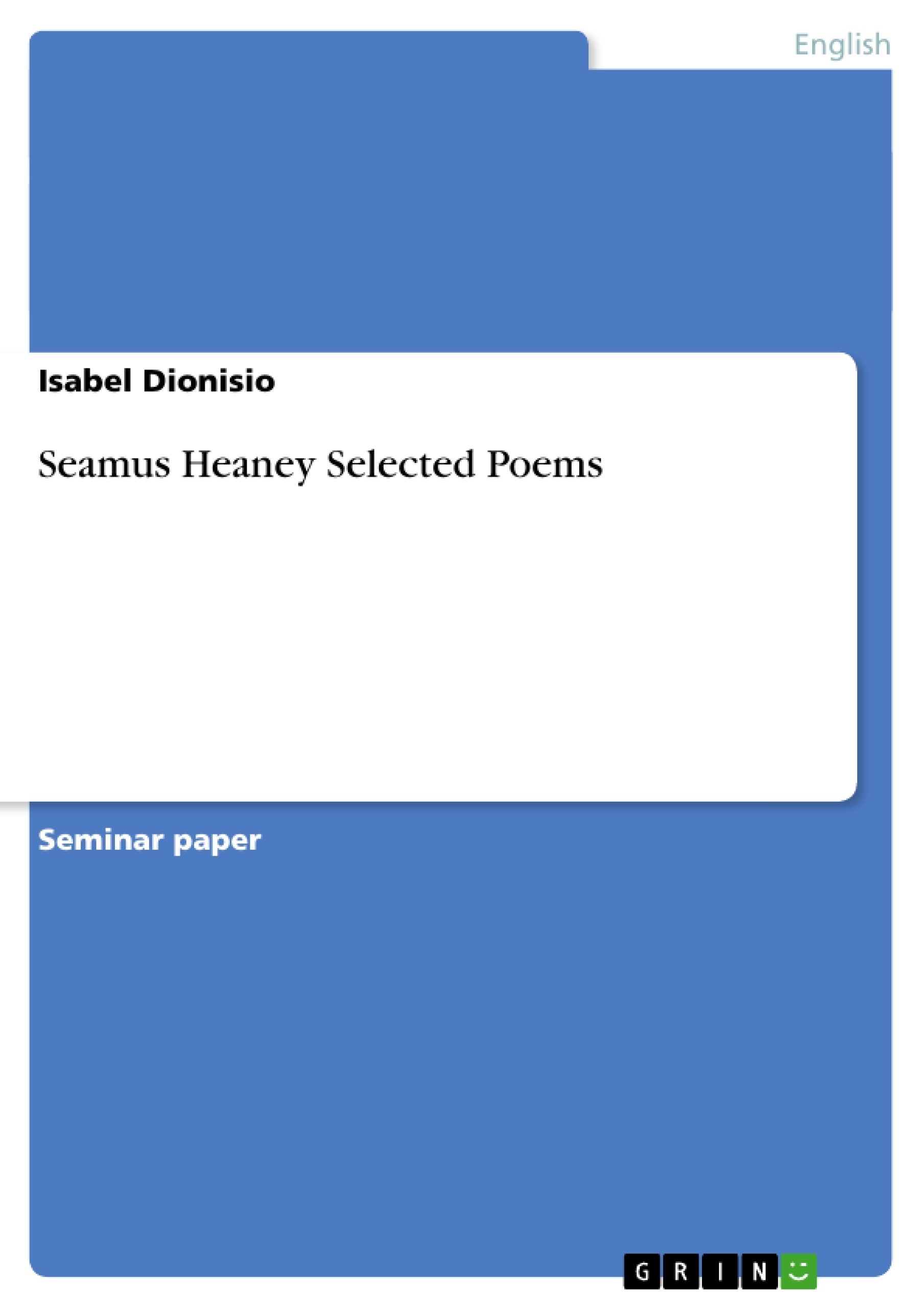In this work I will analyse six poems, all of them are from the same poet unless the last one, which will later be useful as a comparison between one of the poems. After analysing them in detail, I will focus myself on three topics and will try to find similarities within the analysed poems. However, to be able to understand the backgrounds of each poem, I will start with a little biography from Seamus Heaney, who is responsible (the author from) for the major poems that I will analyse.
Inhaltsverzeichnis (Table of Contents)
- Introduction
- Seamus Heaney Biography
- Analysis of Poems: First in Form and Rhyme, then in Language and Subject
- "Digging"
- "Death of a Naturalist"
- "Mid-Term Break"
- "Bogland"
- "Bog Queen"
- "The Song of the Old Mother" by W. B. Yeats
- Similar topics between Poems
- Themes:
- Family Relationship (“Digging”/ “Mid-Term Break\")
- Emotions (all poems)
- The woman figure of Ireland ("Bog Queen"/ "The Song of the Old Mother").
- Themes:
- Conclusion
Zielsetzung und Themenschwerpunkte (Objectives and Key Themes)
This work aims to analyze six poems, highlighting the similarities between them through a thematic approach. It explores the poems in detail, considering aspects such as form, rhyme, language, and subject matter. The analysis is conducted in the context of Seamus Heaney's life and influences, focusing on his childhood and the Irish countryside, which are central themes in his poetry. The chosen poem by W. B. Yeats provides a comparative perspective, allowing for a deeper understanding of the shared themes.
- Family relationships and their significance
- Emotions and their portrayal in poetry
- Themes of nature and rural life
- Cultural identity and the influence of Irish heritage
- The role of the poet and the process of creative writing
Zusammenfassung der Kapitel (Chapter Summaries)
- Introduction: This chapter introduces the six poems that will be analyzed in the work. It briefly describes the approach and objectives of the analysis, highlighting the focus on similarities within the chosen poems. The author also mentions the inclusion of a brief biography of Seamus Heaney to provide context for understanding his poetry.
- Seamus Heaney Biography: This chapter presents a concise overview of Seamus Heaney's life, emphasizing his upbringing in Northern Ireland and the influence of rural life on his poetry. It highlights key events and experiences that shaped his literary career, such as his education, family, and early literary works.
- "Digging": This chapter provides a detailed analysis of "Digging," focusing on its structure, rhyme scheme, and thematic content. The analysis explores how the poem portrays the relationship between the speaker, his father, and his grandfather, highlighting their shared connection to the land and their skills in digging. The chapter discusses the use of imagery and metaphor, particularly the comparison between digging and writing, and the significance of this comparison in understanding Heaney's artistic vision.
- "Death of a Naturalist": This chapter delves into the analysis of "Death of a Naturalist," exploring its themes of childhood innocence, the transition to adulthood, and the impact of nature on the speaker's development. It analyzes the poem's structure, language, and imagery, highlighting key moments that illustrate these themes.
- "Mid-Term Break": This chapter examines "Mid-Term Break," focusing on its poignant portrayal of grief, family, and the fragility of life. The chapter analyzes the poem's language, structure, and imagery, exploring how these elements contribute to the poem's powerful emotional impact.
- "Bogland": This chapter focuses on "Bogland," analyzing its themes of landscape, history, and cultural identity. It explores how the poem's language, imagery, and structure create a sense of place and connect the reader to the Irish landscape and its complex history.
- "Bog Queen": This chapter analyzes "Bog Queen," examining its themes of female figures, mythical narratives, and the complexities of Irish identity. It explores the poem's use of language, imagery, and structure, highlighting the significance of the "Bog Queen" figure in Irish mythology and literature.
- "The Song of the Old Mother" by W. B. Yeats: This chapter compares "The Song of the Old Mother" by W. B. Yeats to the previously analyzed poems by Seamus Heaney, highlighting shared themes and artistic techniques. The chapter examines the similarities and differences in the poets' approaches to themes such as nature, death, and Irish identity, providing a broader perspective on the literary landscape of Ireland.
Schlüsselwörter (Keywords)
This work focuses on the poems of Seamus Heaney, analyzing them through the lens of family relationships, emotions, and the significance of the Irish landscape. The analysis explores themes of childhood, adulthood, nature, rural life, cultural identity, and the role of the poet. Key topics include the comparison between "Digging" and "Mid-Term Break," the portrayal of emotions in various poems, and the woman figure of Ireland as represented in "Bog Queen" and "The Song of the Old Mother." This research aims to deepen our understanding of Heaney's poetic vision and the enduring power of his themes.
- Citar trabajo
- Isabel Dionisio (Autor), 2005, Seamus Heaney Selected Poems, Múnich, GRIN Verlag, https://www.grin.com/document/38732



